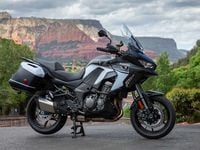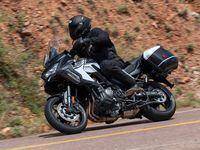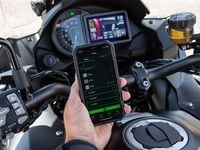For 2019, Kawasaki is introducing the Versys 1000 SE LT+, and it’s alphabet soup in the form of a motorcycle. The core of its popular Versys 1000 tourer stays the same, but it’s now surrounded by new bodywork, and a suite of electronic upgrades that would make Campbell’s jealous.
It starts with Electronic Throttle Valves (ETV), which is Kawasaki’s name for ride by wire. ETV enables four riding modes (Sport, Road, Rain, and a customizable Rider) as well as a long-requested feature: electronic cruise control. When paired with a fix-axis Bosch inertial measurement unit (IMU), the Versys can now compete with the best when it comes to acronym generation.
Like the Versys' MSRP ($17,999 compared to $12,999 last year), let's start from the bottom and work our way up:
Managing how the tires interact with the pavement is KTRC (Kawasaki TRaction Control). There are three modes of control, and you can turn it off. You’ve also got KIBS (Kawasaki Intelligent antilock Brake System), the same system utilized on the H2 and ZX-10R but with software tweaks to match the longer-travel suspension. The “intelligent” descriptor comes from the fact that the system can apply partial pressure instead of completely cutting out braking, which smooths out ABS pulses and shortens stopping distances. Both functions are overseen by KCMF (Kawasaki Cornering Management Function), which manages traction, pitching, and lean-sensitive braking.
Keeping the tires in contact with the road is KECS (Kawasaki Electronic Control Suspension)—the Showa suspension now actively adjusts damping every millisecond depending on your selected ride mode. As you enter a pothole, the Versys can detect the forward pitch and stiffen up the fork, reducing the impact forces. In addition, KECS enables preload adjustments on the fly. If the throttle is closed, you can switch between Rider, Rider and Luggage, or Rider and Passenger while moving.
KQS is the Kawasaki Quick Shifter, which allows for clutchless shifting in both directions. A neutral finder makes it easy to light up the green “N” on the dash when in first gear at a stop. There’s plenty of other upgrades as well, including three-stage cornering lights, three-stage heated grips, “highly durable paint,” and a TFT screen.
The electronics all work as advertised, though the quickshifter was inconsistent. It never missed a shift, but the smoothness of operation was random, no matter the throttle position or selected gear. In addition, the shifter action feels sloppier than it should.
Almost all the electronic trickery can be controlled with a phone app that Kawasaki calls Rideology. It allows you to check the current status of your Versys, change settings, and customize power output, traction control, and suspension settings in Rider mode.
There’s also an interesting bonus where you can track your ride. Other OEMS offer GPS-based tracking, but Kawasaki takes it to another level by also including additional information such as gear position, rpm, Gs of acceleration, brake pressure, and throttle opening percentage.
In the balance of sport-touring, the Versys leans heavily toward the latter. Kawasaki took us to Arizona for a two-day ride from Scottsdale to Flagstaff—a scenic trip with plenty of twisties. The Versys 1000 SE LT+ is deceptively fun to throw around a corner thanks to 17-inch wheels that ensure quick turn-in, Bridgestone Battlax T31 tires that provide more than enough grip, and a chassis that can keep up.
KCMF really shines in this environment, providing a guiding hand to both corner entry and exit. But the motor lacks the urgency that one would hope for from 1,043cc. Kawasaki has opted for smoothness at the expense of power delivery, which is fair considering the intended usage. It also means the Versys is an excellent choice to cover hundreds of miles in a day.
A matching trunk is an available option, as are frame/axle sliders, a shorter seat, auxiliary lights, and a GPS mount. None are necessary as the Versys is well-equipped from the factory for long days in the saddle, though riders above 6-foot-2 should look to the aftermarket for a taller windscreen. The only other drawback is a significant amount of vibration at 6K rpm, though that won’t be an issue in top gear as you’d be doing 95 mph.
With the increased feature set and price, the Versys now occupies a solitary spot in the market. It has left bikes like the Tracer 900 GT behind in terms of electronic offerings, but it’s not up at the level of a BMW S 1000 XR in terms of power. The Versys makes a lot of sense for riders who realize that you don’t need the extra 40-plus horsepower offered by Ducati or BMW to have a life-changing two-up motorcycle tour. But they’ll probably be the same riders who ask if you also need all this technology at a $5,000 premium. Just remember that a similarly equipped S 1000 XR or Multistrada 1260 will set you back nearly $21,000, so even if Kawasaki has gone upmarket, the Versys remains a relative bargain.























/cloudfront-us-east-1.images.arcpublishing.com/octane/VZZXJQ6U3FESFPZCBVXKFSUG4A.jpg)
/cloudfront-us-east-1.images.arcpublishing.com/octane/QCZEPHQAMRHZPLHTDJBIJVWL3M.jpg)
/cloudfront-us-east-1.images.arcpublishing.com/octane/HXOUJXQWA5HBHGRO3EMJIGFMVI.jpg)

/cloudfront-us-east-1.images.arcpublishing.com/octane/3TIWWRV4JBBOLDVGRYECVVTA7Y.jpg)
/cloudfront-us-east-1.images.arcpublishing.com/octane/KIX5O23D5NAIBGFXBN3327DKZU.jpg)
/cloudfront-us-east-1.images.arcpublishing.com/octane/7GJYDUIPXRGMTMQKN6ONYOLBOU.jpg)
/cloudfront-us-east-1.images.arcpublishing.com/octane/MUQLOVLL2ZDGFH25ILABNBXKTI.jpg)
/cloudfront-us-east-1.images.arcpublishing.com/octane/TNOU5DNE2BC57MFPMGN2EIDXAM.jpg)
/cloudfront-us-east-1.images.arcpublishing.com/octane/GTCXACQGJ5HAPDTGWUQKDEH44E.jpg)
/cloudfront-us-east-1.images.arcpublishing.com/octane/S35YGSEMEZB4BLTDJTSZPF4GLA.jpg)
/cloudfront-us-east-1.images.arcpublishing.com/octane/5UOT6HPX2JFMRJAX6EH45AR4MQ.jpg)
/cloudfront-us-east-1.images.arcpublishing.com/octane/OKWOJWAKP5EP3OACCRRWPCIX2Q.jpg)
/cloudfront-us-east-1.images.arcpublishing.com/octane/2WF3SCE3NFBQXLDNJM7KMXA45E.jpg)
/cloudfront-us-east-1.images.arcpublishing.com/octane/G4MG6OUCJNBSHIS2MVVOTPX65E.jpg)
/cloudfront-us-east-1.images.arcpublishing.com/octane/IIGGWFOTOJGB7DB6DGBXCCMTDY.jpg)
/cloudfront-us-east-1.images.arcpublishing.com/octane/QSTCM6AVEZA5JJBUXNIQ3DSOF4.jpg)
/cloudfront-us-east-1.images.arcpublishing.com/octane/U4I7G625B5DMLF2DVIJDFZVV6M.jpg)
/cloudfront-us-east-1.images.arcpublishing.com/octane/B6XD6LS6IVCQPIU6HXDJSM3FHY.jpg)
/cloudfront-us-east-1.images.arcpublishing.com/octane/ICL63FEDDRDTTMINYICCEYGMDA.jpg)
/cloudfront-us-east-1.images.arcpublishing.com/octane/FCGZHQXRBZFLBAPC5SDIQLVF4I.jpg)
/cloudfront-us-east-1.images.arcpublishing.com/octane/WNOB6LDOIFFHJKPSVIWDYUGOPM.jpg)

/cloudfront-us-east-1.images.arcpublishing.com/octane/X33NU3E525ECRHXLNUJN2FTRKI.jpg)